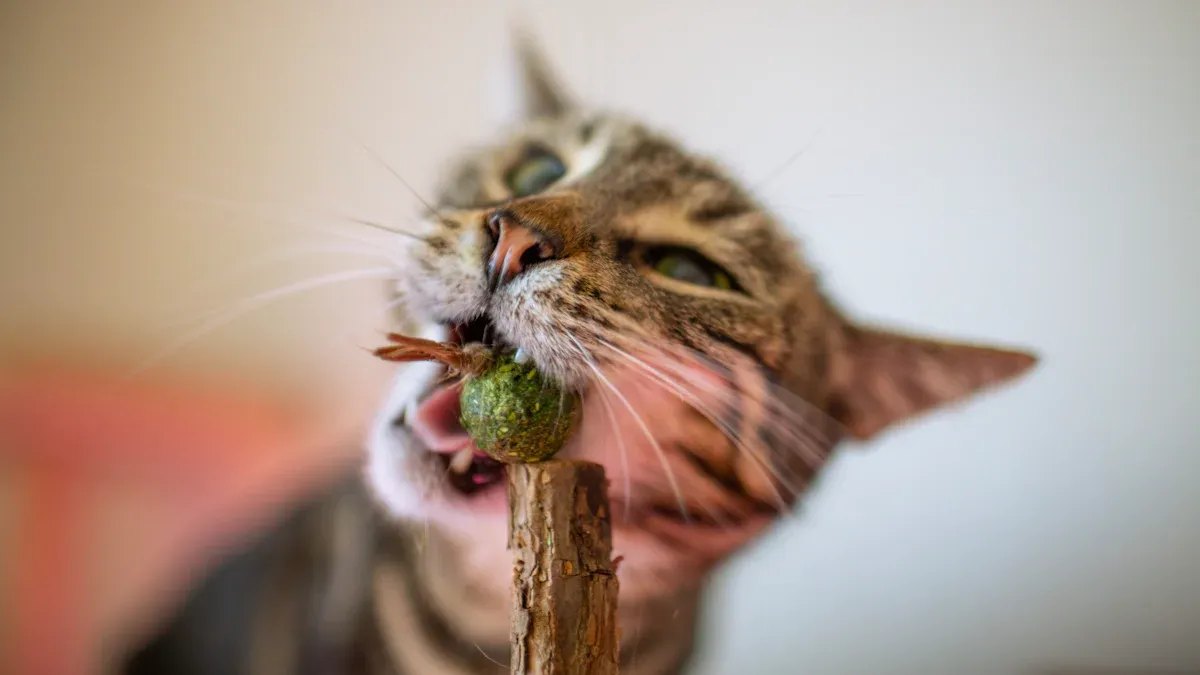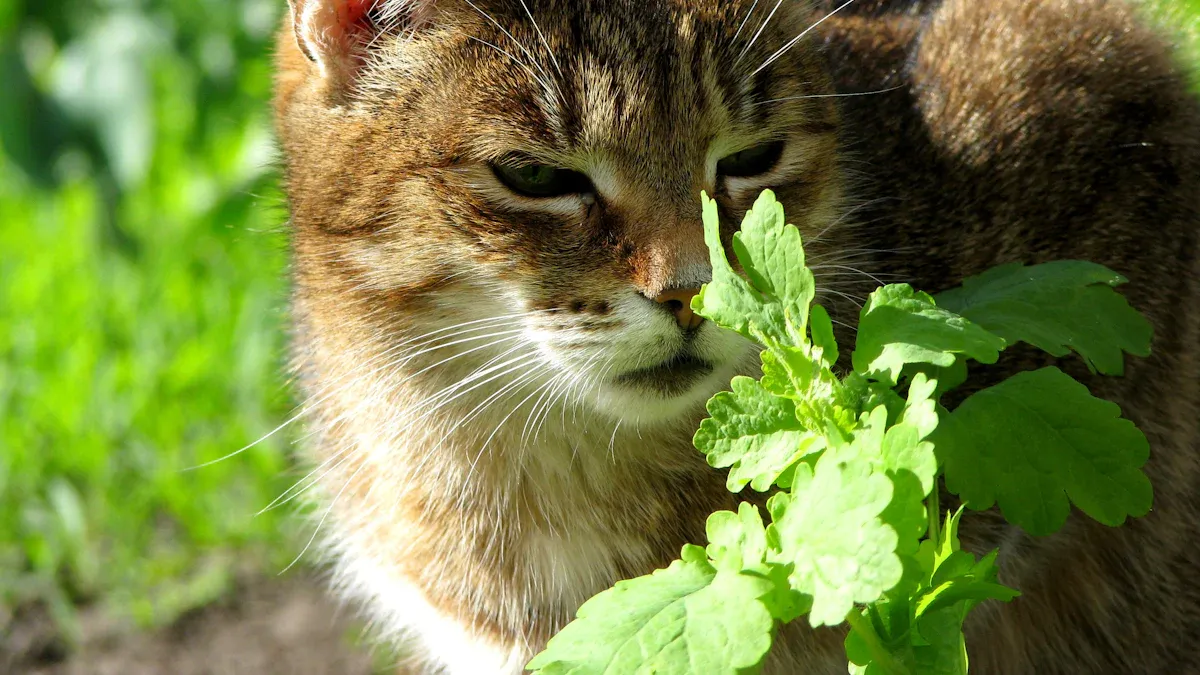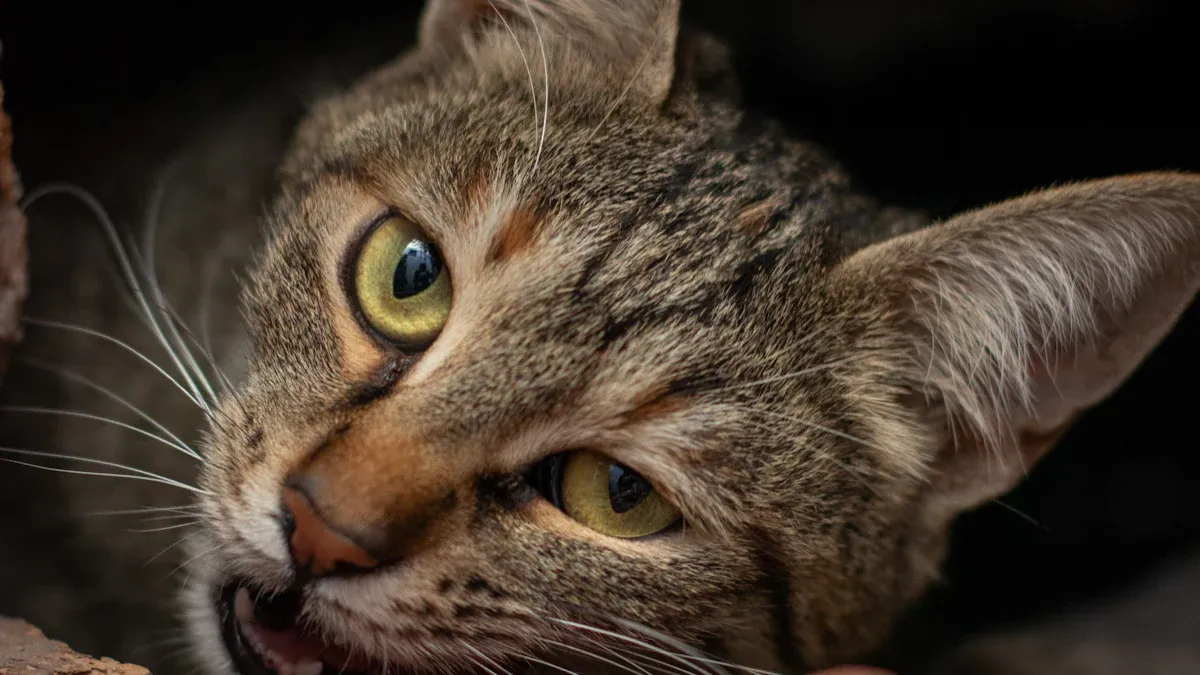Views: 0 Author: Site Editor Publish Time: 2025-07-12 Origin: Site










Catnip offers a unique experience for cats. When you give your feline catnip, you may see playful rolling, purring, or energetic bursts. Catnip contains a natural compound called nepetalactone, which triggers these behaviors in many felines. Scientific studies show that about 50-70% of domestic cats respond to catnip, while others remain unaffected due to genetics. Catnip ball toys continue to gain popularity among cat owners, making up a significant share of the cat toy market. You may notice your cat showing curiosity or excitement around catnip products, especially the Catnip Ball Toy.
Catnip contains nepetalactone, a natural compound that triggers playful or calm behaviors in about 70% of cats due to genetics.
Catnip ball toys provide safe, fun ways to encourage your cat’s exercise, reduce stress, and support dental health.
Introduce catnip toys gradually and watch your cat’s reactions to avoid overstimulation or mild side effects like restlessness.
Use catnip in moderation, offering it once or twice a week to keep it effective and safe for your cat’s well-being.
Catnip is generally safe for cats of all ages, but kittens under six months may not respond, and senior or sick cats need careful monitoring.

Catnip is a fascinating herb that belongs to the mint family. You may know it by its scientific name, Nepeta cataria. This plant grows as a perennial or annual and thrives in many regions, including Europe, Asia, Africa, and North America. Catnip produces heart-shaped leaves and small, pale flowers. The plant contains several active compounds, but nepetalactone stands out as the main one responsible for the unique reactions you see in cats.
Did you know? Catnip also contains geranyl acetate, 1,8-cineole, citronellyl acetate, cis- and trans-linalool oxides, p-cymene, and iridoid glucosides like nepetolglucosylester and nepetaside. These compounds contribute to the plant’s aroma and its traditional medicinal uses.
Here’s a quick look at catnip’s botanical details and its primary active compounds:
| Aspect | Details |
|---|---|
| Botanical Classification | Species: Nepeta cataria |
| Genus: Nepeta | |
| Family: Lamiaceae | |
| Distribution | Herbaceous perennial and annual plants found in Europe, Asia, Africa, and North America |
| Primary Active Compounds | Nepetalactone (volatile oil responsible for characteristic effects) |
| Geranyl acetate | |
| 1,8-cineole | |
| Citronellyl acetate | |
| Cis- and trans-linalool oxides | |
| p-cymene | |
| Iridoid glucosides: nepetolglucosylester, nepetaside |
When you ask, "how does catnip work," the answer lies in nepetalactone. This compound acts as a stimulant when cats smell it. It triggers a burst of activity, such as rolling, darting, and flipping. If a cat eats catnip, the effect changes. The plant then acts as a mild sedative. Scientists believe nepetalactone mimics natural pheromones, causing psychoactive effects that last about 15 to 30 minutes. Catnip effects can include both hyperactivity and calmness, depending on how your cat interacts with the plant.
You might wonder, "why do cats like catnip?" The answer involves both genetics and behavior. Not every cat responds to catnip. The ability to react is hereditary. About 70 to 80 percent of cats show the classic behaviors, while others remain unaffected. The specific genes responsible are still unknown, but the response usually appears after a cat reaches six months of age, which is around the time of sexual maturity.
The response to catnip is hereditary, with about 70-80% of cats showing the behavior.
The exact genes responsible remain unidentified.
Most kittens under six months do not react to catnip.
Nepetalactone binds to receptors in the cat’s nasal tissue, triggering a neurological response.
This response involves brain regions like the amygdala and hypothalamus, which control emotions and sexual behaviors.
When you observe cats and catnip together, you may notice a range of behaviors. Cats often sniff, lick, and chew the plant. Many will shake their heads, rub their faces and bodies, paw at the catnip, roll around, drool, and even vocalize. Some cats appear euphoric or seem to "zone out" for five to fifteen minutes. Occasionally, a cat may show increased aggression during this time. The reaction is harmless and non-addictive, and it often encourages playful activity.
Tip: The behaviors you see may help cats transfer nepetalactone to their fur, which acts as a natural insect repellent. This can reduce mosquito landings by about half.
Scientists have found that nepetalactone activates the opioid system in the feline brain. This raises beta-endorphin levels, which create feelings of pleasure and pain relief. The result is a euphoric state that explains why cats enjoy catnip so much. If you ask, "how does catnip work," you now know it involves both brain chemistry and inherited traits.
The response to catnip varies across the world. Take a look at how cats from different countries react:
| Country | Catnip Response Rate (%) | Immunity Rate (%) | Notes |
|---|---|---|---|
| Canada | 82 | 18 | Highest response rate among surveyed countries |
| USA | 79 | 21 | High response rate |
| UK | 74 | 26 | High response rate |
| Japan | 71 | 29 | High but not highest response rate |
| Germany | 57 | 43 | Moderate response rate |
| Brazil | 56 | 44 | Moderate response rate |
| Spain | 54 | 46 | Moderate response rate |
| Australia | 46 | 54 | Notably lower response rate, confirmed by follow-up surveys |
| Mexico | 52 | 48 | Moderate response rate |

You can see that the response to catnip depends on both genetics and environment. Some populations have higher response rates than others. This helps explain why your cat may love catnip, while another cat ignores it completely.
When you consider the benefits of catnip, you find more than just entertainment. Catnip can encourage exercise, reduce stress, and even help with insect control. The unique relationship between felines and catnip continues to fascinate scientists and pet owners alike.

A catnip ball toy gives your cat a fun and safe way to enjoy catnip. You can find these toys in many shapes and sizes, but the main idea stays the same. The toy contains catnip or uses compressed catnip balls to attract your cat and encourage play. SKYLARK’s catnip ball toy stands out for its thoughtful design and quality materials. You get a round, plush ball that measures 57 cm and weighs 25 grams. The toy uses plastic and plush, making it soft yet durable for chewing and batting. You can choose from red or blue colors. SKYLARK’s toy does not use electricity, so you never worry about batteries or charging. The packaging is simple, and the product meets safety standards like RoHS, CE, ISO, and CCC.
| Feature | Description |
|---|---|
| Product Name | Cat Toy Clown Cat Stick Plush Ball with Long Bell Fairy Cat Stick |
| Function | Chew toy for cats |
| Material | Plastic and plush |
| Shape | Round |
| Size | 57 cm |
| Weight | 25 g |
| Color Options | Red, Blue |
| Electric | No (Non-electric) |
| Packaging | OPP bag |
| Certification | RoHS, CE, ISO, CCC |
| Customization | OEM/ODM customization acceptable |
| Logo Printing | Optional (with or without logo) |
You can find several types of catnip ball toys on the market. Compressed catnip balls keep the catnip together, so you avoid the mess of loose catnip. Some toys stick to walls, letting your cat lick and play at different heights. Others use natural materials like silvervine or offer refillable options for long-lasting use. Each type brings unique enrichment and playtime experiences for your cat.
Catnip ball toys offer many benefits for cats and their owners. When your cat chews or licks compressed catnip balls, the action helps clean teeth and reduce plaque. This supports dental health and leads to fresher breath. Catnip-infused toys also help lower stress and anxiety, making your cat feel more relaxed at home. Interactive catnip ball toys keep your cat active and alert. They encourage natural hunting behaviors, such as chasing and pouncing, which improve muscle tone and coordination.
Promote dental health by reducing plaque and tartar.
Provide stress relief and help with anxiety.
Offer mental and physical enrichment through interactive play.
Reduce boredom and prevent destructive behaviors.
Use safe, non-toxic materials for worry-free play.
You can use catnip ball toys as part of your cat’s daily enrichment routine. These toys support the benefits of catnip by making playtime more exciting and rewarding. Catnip products like compressed catnip balls give your cat a safe outlet for chewing and licking, which can redirect unwanted chewing habits. Catnip-infused toys also help indoor cats stay active and happy.
Tip: Rotate different types of catnip ball toys to keep your cat interested and provide new enrichment opportunities.
If you want to introduce catnip to your cat, start with a simple approach. Many cat owners ask, "How do I introduce catnip to my cat?" or "How to use compressed catnip balls?" Follow these steps for a smooth introduction:
Offer the compressed catnip balls for a short playtime at first. This keeps the experience special and prevents your cat from losing interest.
Store the balls in a sealed bag between uses. You can add a pinch of dried catnip to the bag to refresh the scent.
Watch your cat closely as it interacts with the toy. Cats often chew on compressed catnip balls, so supervision helps keep them safe.
Check the toy for any signs of damage before each use. Remove the toy if you see broken pieces.
Roll or toss the ball to trigger your cat’s natural prey drive. This encourages curiosity and active play.
If you wonder how to use compressed catnip balls for the first time, remember that patience is key. Some cats may need a few tries before they show interest. SKYLARK’s compressed catnip balls use natural materials and a safe design, making them a great choice for your pet.
Knowing how to use catnip safely helps you avoid overstimulation. Watch for these signs in cats during playtime:
Sudden bursts of energy or darting around
Unusual meowing or chattering
Aggressive behavior or swiping
Disorientation or stumbling
Vomiting or stomach upset
If you notice these behaviors, stop play and give your cat a quiet space to relax. Limit how often you use compressed catnip balls to keep the experience positive. Replace dirty or damaged toys instead of washing them, since cleaning can reduce the catnip’s effect. Regular inspection ensures ongoing safety.
Tip: Rotate different catnip toys to keep your cat engaged and prevent boredom.
SKYLARK’s compressed catnip balls offer a safe, fun way to enrich your cat’s environment. Knowing how to use compressed catnip balls and how to use catnip responsibly helps you create a healthy, happy routine for your pet.
Catnip is a favorite treat for many cats, but you may wonder about its safety. You might ask, "is catnip safe for cats?" The answer is yes, catnip is generally safe when you use it in moderation. Scientific studies show that catnip does not affect your cat’s brain like drugs such as marijuana or cocaine. Your cat stays aware of its surroundings and only experiences a temporary feeling of happiness. Catnip does not cause addiction or long-term effects. You can feel confident about offering catnip as a fun reward.
Most cats enjoy catnip without any problems. However, you should know about possible side effects. If your cat eats too much catnip, it may experience mild stomach upset. You might see vomiting or diarrhea. Some cats become restless or hyperactive after playing with catnip. These reactions usually last less than 30 minutes and go away on their own.
Here are some common side effects you may notice:
Mild gastrointestinal upset, such as vomiting or diarrhea
Short periods of hyperactivity or restlessness
Rarely, aggression or unusual behavior
Lethargy if your cat overindulges
Catnip is not a true toxin, but large amounts can cause a poison-like reaction. The active compound, nepetalactone, triggers these effects but is not inherently toxic. Most cats self-regulate and stop using catnip before they reach this point. If you wonder, "how much catnip is too much," you should offer catnip once or twice a week and watch your cat’s reaction. Overuse can lead to tolerance, making catnip less effective over time.
Note: If your cat shows persistent vomiting, diarrhea, or distress after using catnip, contact your veterinarian. Cats with medical conditions, such as heart problems or anxiety disorders, may need special care. Always check with your vet if you have concerns.
You may also ask, "is catnip a drug?" Catnip does not act like a drug in the human sense. It does not cause addiction or withdrawal. Your cat’s playful or relaxed state is temporary and harmless.
You should consider your cat’s age and health before introducing catnip. Many people ask, "can kittens have catnip?" Most kittens do not respond to catnip until they reach about six months old. Their bodies need time to develop the genetic response. If you offer catnip to a kitten, watch closely for any reaction, but do not expect much interest.
Senior cats may react differently to catnip. You should observe older cats for signs of stress or overstimulation. Start with a small amount, such as sprinkling catnip on a favorite resting spot. Choose soft, plush catnip toys that are easy for senior cats to handle. This helps if your cat has dental sensitivities or limited mobility. Allow breaks between play sessions to prevent overstimulation. Catnip effects usually last 10 to 15 minutes, so give your cat time to rest.
Here is a quick guide for special situations:
| Cat Type | Recommendation |
|---|---|
| Kittens | Most do not respond; safe to try in small amounts; monitor for any reaction |
| Senior Cats | Start gradually; use soft toys; watch for stress; limit exposure if needed |
| Medical Issues | Consult your vet before use, especially for heart or anxiety conditions |
| Multi-Cat Homes | Limit catnip use to prevent fighting or aggressive behavior |
If you ever wonder, "can kittens have catnip" or "is catnip a drug," remember that catnip is safe for most cats, but you should always use it responsibly. If your cat has a medical condition or shows unusual behavior after using catnip, consult your veterinarian. Persistent vomiting or diarrhea after catnip use also requires a vet visit.
Tip: To keep playtime safe, avoid giving catnip when your cat is on high surfaces. Hyperactive cats may jump or fall, risking injury.
You may also ask, "how much catnip is too much?" The best approach is moderation. Offer catnip once or twice a week and watch your cat’s response. This keeps catnip fun and safe for your pet.
Catnip can be a wonderful way to enrich your cat’s life. When you use it wisely, you support your cat’s happiness and well-being.
Catnip offers more than just fun for your cat. Scientific research shows that catnip not only boosts mood but also helps repel pests. You should always test your cat’s interest and use catnip ball toys in moderation. Limit playtime to prevent overstimulation and store toys properly for freshness. Choose trusted brands like SKYLARK for safe, high-quality options. Responsible use ensures your cat enjoys all the benefits catnip provides.
You can offer catnip once or twice a week. This keeps the experience special for your cat. Too much catnip may reduce its effect over time. Always watch your cat’s reaction and adjust the frequency if needed.
Not every cat reacts to catnip. Genetics play a big role. About 70% of cats show interest. If your cat does not respond, try toys with silvervine or valerian root for similar stimulation.
Tip: Rotate catnip toys to keep your cat interested.
You should not leave catnip toys out constantly. Limit access to short play sessions. This prevents overstimulation and keeps the toys exciting for your cat.
If your cat eats too much catnip, you may notice mild stomach upset. Remove the toy and offer water. Most cats recover quickly. If symptoms last, contact your veterinarian for advice.
Most kittens do not respond to catnip until about six months old. You can let kittens try catnip toys, but do not expect much interest. Always supervise play to ensure safety.